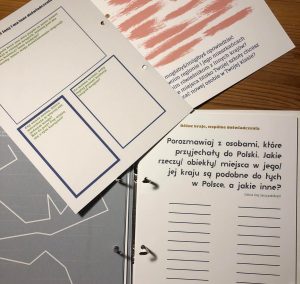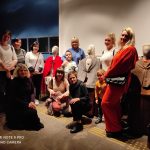NEW ABC wants to share some tips to make it easier for you to adapt the activities to your own context. Click on each of them to see a longer explanation with examples and further details.
Evaluate the most suitable way to approach linguistic and cultural diversity
Feel free to adapt the activities included in this action according to your context and participants. For example, the focus might not be the same if you are working on linguistic and cultural diversity with local or long-time settled migrant communities, or if your participants are recently arrived refugees, who might need a different approach to discover the linguistic and cultural heritage of the host community.
Plan with flexibility and avoid frustration if activities do not go as expected
Instead, allow pupils to lead and eventually transform the activities according to their needs and interests. For example, children might be interested in using the proposed activities to discuss other related experiences and concerns or to use other ways to express their points of view. Thus, when planning your activities, try to provide different options and spaces for pupils’ decision-making, and don’t get stressed in the face of unexpected changes, as this is part of co-creation.
Do not pre-define what languages, cultures and other key concepts are
Following principles of co-creation and collaboration, avoid imposing pre-established definitions of the action’s key concepts and allow children to express and build their own understandings of languages and cultures according to their repertoires and life experiences. Keep an open mind and consider that starting from what is relevant for them will probably make your action more meaningful and engaging.
Explore the neighbourhood where your action will be developed before going out with pupils
This will allow you to identify potential opportunities and challenges for children’s exploration during the field trip activity so that you can better promote and support their reflection about the cultural and linguistic landscapes around them. Having a previous idea of what can be found in their local context can also be helpful in deciding how many groups to create for the outing and how many adults will be needed to watch them over, as well as how many sites to document per group and which areas might be more convenient to explore.
Identify some engaging resource(s) that might work as a trigger to start your action
This could be for example a music video, a short, animated film, or any other resource from child/youth popular culture that might serve to introduce the topic of linguistic and cultural diversity in an attractive way and to encourage pupils to talk about their related experiences. Using an engaging ‘hook’ on your first session might make a big difference in children’s disposition towards deeper reflection in the upcoming activities. You can also use this resource to open the room for pupils’ own preferences.
Give voice and recognition to pupils’ multiple experiences, languages, cultures, manners and ways of behaving
Many of the things that children know and do in their daily lives are not usually visible or acknowledged at school, including the languages that they know and use at home, as well as other features and skills. Look for opportunities to let these practices emerge and be praised within this action, so that children know that their whole linguistic and cultural repertoires are valued. For example, you can encourage pupils to use their home languages in the activities and to teach some key concepts to their peers and adult facilitators, or to bring in and include their cultural knowledge into the activities.
Allow children to use multiple forms of participation
It is well known that embodied and arts-based approaches allow pupils to express feelings and ideas that do not always emerge through other channels. Use your imagination when planning the activities and encourage pupils’ participation through multiple and creative forms that go beyond typical school dynamics, usually based on oral or written expression. For example, you can include spaces for drawing as an alternative to writing for those children who are not yet fluent in the school language, or encourage the use of role-plays, games, singing, dancing and other ways of expression that might broaden everyone’s chances for participation.
Give space to local artists to allow children to come into contact with diverse forms of expression
An engaging way to open spaces for pupils’ creativity and participation in this action is by inviting one or more local artists to share their work and engage the pupils in a collaborative artistic performance. This exchange might help pupils to get to know different forms of artistic creation that might be available for them to perform and their affordances for self-expression.
Be a model and be part of the reflection
Use this action to reflect on your own linguistic and cultural experiences, and share your story with pupils. For example, create your own autobiographical account and share it with pupils, explaining your life trajectory in relation to languages, varieties and cultures. Along with being a model for their reflections, you might be surprised by your own findings!
Carefully guide the activities, so that sensible issues that might emerge can be discussed and critically revised
Don’t be surprised if the intended reflection around linguistic and cultural diversity leads children to express their opinions or concerns around other sensible topics, such as racism and other forms of discrimination. It might also be the case that during the activities they express their own linguistic and cultural prejudices and stereotypes about certain languages, accents or communities. Rather than avoiding these topics, try to be prepared and use them for critical reflection.
Be ready to redirect the discussion of pupils back to the main points
So far, we have recommended to be flexible and let pupils’ interests guide the action. However, there might be times when their initiative leads them far from the main topics and objectives of the proposal, into directions where they might lose the opportunity to reflect on the linguistic and cultural diversity around them. If this is the case, you can have some strategies prepared to bring them back to the topic, for example by sharing a personal experience and asking for their opinion, or by displaying some engaging audiovisual resource that might promote group discussion.
Involve families and other members of the school or the community as much as possible
When planning your activities, think of possible ways to involve pupils’ families and the wider community both in the action processes and in the final outcomes. This can be done by asking pupils to explain or to implement some of the activities at home (for example, they might create the linguistic biography of a family member) and bring some feedback back to the sessions. And, of course, family involvement can be promoted by organizing some type of final presentation for parents, siblings, friends, and the rest of the school and out-of-school community, as we did in our action.
Save some time after each activity and at the end of the project for collective reflection
This might be an important space for connecting the work done and the experiences lived during each session with the main objectives of the action. As in previous tips, you can also be creative here and propose diverse and dynamic forms of critical reflection, so that everyone finds a way to participate. If there is not much time in every session for a proper collective reflection, you can use some sort of ‘exit pass’, asking pupils to share one word or brief comment about that day before leaving the room.
 Type of action
Type of action













